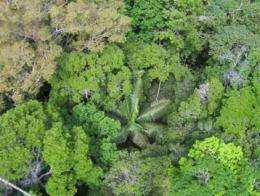DNA 'barcode' for tropical trees

In foods, soil samples or customs checks, plant fragments sometimes need to be quickly identified. The use of DNA “barcodes” to itemize plant biodiversity was proposed during the 1992 Rio de Janeiro Summit. Jérôme Chave's team from the Evolution et diversité biologique laboratory has tested this method in the tropical forest where the CNRS Nouragues, French Guiana research station is located. Their study, published in PlosOne, shows that while the identification of plant species has improved considerably, some aspects of this method remain problematic, especially for tropical species.
Creating a large-scale inventory of plant biodiversity is essential for the development of conservation strategies. Within the framework of the Convention on Biological Diversity, the use of DNA barcoding was proposed for the identification of plant and animal species. This method consists of using tissue to sequence short DNA fragments which contain a substantial amount of information. These fragments are then compared to a reference collection to identify their origin. In August 2009, after several years of debate, an international consensus headed by the Plant Working Group of the Consortium for the Barcode of Life (CBoL) was reached, according to which two DNA markers (two gene regions dubbed rbcL and matK) would suffice to characterize 250,000 plant species.
The team from the Toulouse Evolution et diversité biologique laboratory, in collaboration with Guyanese partners, conducted the first test of this DNA barcoding method in a tropical forest environment. A total of eight candidate barcodes were tested on over 200 tree species sampled at the CNRS Nouragues research station in French Guiana. More than 2,000 DNA sequences were thus generated for this project. The study yielded significant progress in species discrimination. However, identification success did not exceed 70% and one of the two markers proposed by CBoL proved very difficult to sequence.
At the crossroads between basic research and applied research, this work suggests that despite being an invaluable tool for identifying plant species, the international DNA barcoding method poses problems for exclusively tropical plant families. Solving them would, among other things, enable researchers to itemize and track the biodiversity of Amazonian plants much more efficiently.
More information: "Identification of Amazonian trees with DNA barcodes". M-A Gonzalez, C Baraloto, J Engel, SA Mori, P Pétronelli, B Riéra, A Roger, C Thébaud, J Chave. (Published October 16, 2009). PloS ONE 4(10): e7483. doi:10.1371/journal.pone.0007483
Provided by CNRS















